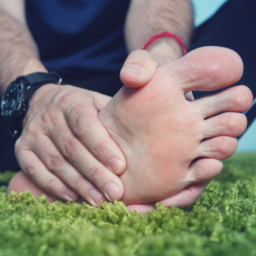
Are you troubled with aching joints? Maybe you think it’s arthritis, stiff joints or sore muscles. You may think you injured or even broke your foot, toe, wrist or finger. While this may be the case, you should also consider that you may have gout.
What is Gout?
Historically, gout was considered the “disease of kings” because it was commonly a condition of overeating and drinking too much alcohol. King Henry VIII supposedly suffered from gout. (1) Cases of gout have been on the rise in the United States, rates having doubled since the 1960s. Currently, almost 8.3 million Americans suffer from gout. (2)
Gout is a type of joint pain that happens when there is too much uric acid in the body. Uric acid is the end product of breaking down the chemical compound purine. Purines make up important molecules DNA and RNA, and biochemicals like ATP, cAMP, Coenzyme A.They contain nitrogen, so, when they are broken down, uric acid is created with that nitrogen and excreted via urine.
Why is it so painful?
Purines are broken down by the enzyme uricase which oxidizes uric acid into absorbable solutes, or things that can be flushed away. When this system is overloaded, uric acid builds up, crystallizes into needle-like sediment and stabs its way into tissues. Yes, it’s as painful as it sounds. The hallmark symptoms of gout are usually sore, hot, swollen joints, usually involving the big toe. Gout pain can feel excruciating – even sending someone to the ER because they think they broke a bone. Other times, it can just feel like arthritis or muscle soreness. An X-Ray may show punched-out (or rat-bite) erosions in a joint, but this finding doesn’t usually manifest until a year or more of uncontrolled disease. (3)
Although common in the big toe, gout can and does affect other areas like feet, ankles, wrists and fingers. Uric acid crystallizes easier with lower temperatures, so often this pain is worse with cold weather. Uric acid itself is actually not a poison to the body. On the contrary, it is actually an antioxidant, when it is not crystallized out. When in excess beyond what the uricase enzyme can eliminate, the pathology is created.
Testing
Blood and urine tests ordered by your primary care provider can measure uric acid. Hyperuricemia exists when blood values exceed 6.0 mg/dl. However, not all gout cases have elevated blood uric acids – sometimes the blood values are normal. But a sample of joint, or, synovial fluid may contain the telltale uric acid crystals. Urinary uric acid levels aren’t really used to assess gout – that is more for kidney function evaluations.
Dietary Contributors
So what causes uric acid crystals to build up? Well, for starters, too many purines in the diet. Purine rich foods include beer, wine, red meat, pork, bacon, shellfish, and foods containing excess sugar like soda pop, candy, cereals. Lack of vegetables and foods rich in quality antioxidants like vitamin C, A, and B vitamins also tips the balance towards gout.
Fructose (the sugar found in fruit) metabolism results in purine production. Fruits with the most fructose are grapes, watermelon, pears, peaches, prunes, dates, raisins, and really sweet apples. Fruit juices usually concentrate the fructose, so it is really easy to over-consume fructose when drinking them.
However, the motherload of all fructose is High Fructose Corn Syrup. Within minutes of drinking this sweet toxin, uric acid levels increase in the blood.(4,5) High fructose corn syrup has become a predominant food ingredient over the last 40 years. Obesity, diabetes, cirrhosis of the liver, and heart disease have all been linked to its consumption. If I could give only one piece of valuable advice to save yourself from gout, it would be, by far, to stay away from high fructose corn syrup.
Other Risk Factors
Other health concerns that increase the development of hyperuricemia are Type II Diabetes, high blood pressure, hypothyroidism, kidney disease, dehydration, obesity, excess iron and alcoholism. Certain medications like diuretics (thiazides and loop diuretics) also increase propensity for developing gout. Some people do have a genetic predisposition for poor uric acid elimination, so that genetic background paired with the other contributing factors is double trouble.
Diet and Supplement Support
So, how can you outsmart gout? With healthy foods of course. It’s another case of green foods to the rescue! Superfoods that reduce gout flares are broccoli, kale, spinach, swiss chard, mustard greens, and cabbage. Foods rich in bioavailable vitamin C are the best for dissolving the uric acid sediment. If you don’t regularly eat these vegetables, you can give yourself a concentrated dose by juicing them. Don’t have a juicer? Peoples Rx has the Love Cleanse and Joyful Greens – cold-pressed organic juices that are made fresh daily. Even consuming one of these fresh, low sugar juices each day adds in these missing foods and key nutrients.
Can you just take supplements? Yes – Vitamins A, C, E, K, and Methyl Folate and Methyl B12, as well Selenium are all top antioxidants that are used to support gout. But if we were to consider one supplement only that packs the biggest punch, a very strong tart cherry concentrate called Cherry Elixade is our go-to. Tart cherry has actually been clinically shown to lower serum urate levels and decrease inflammation due to gout attacks. (6)
It is possible to fix gout. Once you adjust your diet, exercise habits, and maintain proper nutrition and hydration, this can stay out of your life for good. Come into Peoples Rx to find out more about how quality supplements can support your healing. We can help you feel like a king or a queen, but for a much better reason.
If you have comments and/or questions about this blog, email us at blog@peoplesrx.com.

Amy Nelson, ND* received her Naturopathic Doctorate from the National College of Natural Medicine in Portland, OR where she studied nutrition, homeopathy, herbal and functional medicine. In addition, Dr. Nelson was the Associate at The IBS Treatment Center in Santa Monica where she treated irritable bowel syndrome and complex food allergies. Dr. Nelson utilizes her experience in natural medicine to address female and male hormonal imbalances, mental health, and digestive disorders. Amy is available for consultation at Peoples Lakeline.
*Although licensed in other states, Naturopathic Doctors are not currently licensed in Texas. To support licensure efforts, please visit www.txand.org.
References:
- Chalmers CR, Chaloner EJ. 500 years later: Henry VIII, leg ulcers and the course of history. J R Soc Med. 2009 Dec;102(12):514-7. doi: 10.1258/jrsm.2009.090286. PMID: 19966126; PMCID: PMC2789029.
- Zhu Y, Pandy BJ, Choi HK. Prevalence of gout and hyperuricemia in the US general population: The National Health and Nutrition Examination Survey. Arthritis Rheum.2011;63:3136-3141.
- George C, Minter DA. Hyperuricemia. [Updated 2022 Jul 18]. In: StatPearls [Internet]. Treasure Island (FL): StatPearls Publishing; 2022 Jan-. Available from: https://www.ncbi.nlm.nih.gov/books/NBK459218/
- Rho YH, Zhu Y, Choi HK. The epidemiology of uric acid and fructose. Semin Nephrol. 2011 Sep;31(5):410-9. doi: 10.1016/j.semnephrol.2011.08.004. PMID: 22000647; PMCID: PMC3197219.
- Moeller SM, Fryhofer SA, Osbahr AJ 3rd, Robinowitz CB; Council on Science and Public Health, American Medical Association. The effects of high fructose syrup. J Am Coll Nutr. 2009 Dec;28(6):619-26. doi: 10.1080/07315724.2009.10719794. PMID: 20516261.
- Lamb KL, Lynn A, Russell J, Barker ME. Effect of tart cherry juice on risk of gout attacks: protocol for a randomized controlled trial. BMJ Open. 2020 Mar 15;10(3):e035108. doi: 10.1136/bmjopen-2019-035108. PMID: 32179562; PMCID: PMC7073821.
